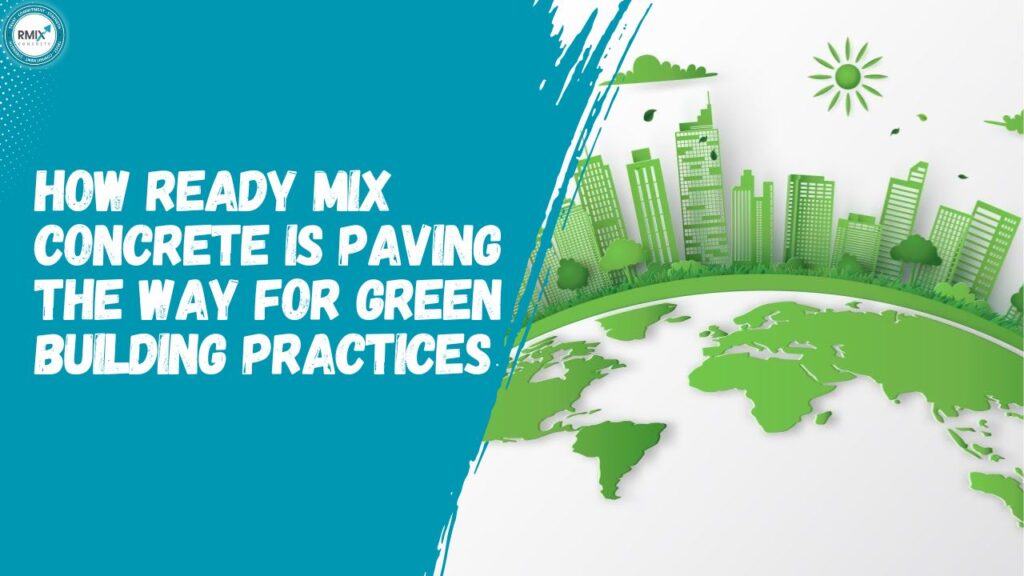
How Ready Mix Concrete is Paving the Way for Green Building Practices
As the construction industry faces increasing pressure to reduce its environmental impact, Ready Mix Concrete (RMC) has emerged as a key player in promoting sustainable building practices. By integrating innovative technologies and eco-friendly materials, RMC is transforming the way structures are built, making them more energy-efficient, durable, and environmentally responsible.
Understanding the Environmental Impact of Traditional Concrete
Traditional concrete production is a significant contributor to global CO₂ emissions, primarily due to the energy-intensive process of producing Portland cement. This has led to a growing demand for alternative materials and methods that can reduce the carbon footprint of construction projects.
“Rmix is a leading RMC manufacturer in Surat, delivering top-quality ready mix concrete for all types of construction projects. With advanced technology and strict quality control, Rmix ensures strength, durability, and timely delivery.“
Sustainable Innovations in Ready Mix Concrete
1. Incorporation of Supplementary Cementitious Materials (SCMs)
SCMs such as fly ash, slag, and silica fume are increasingly used in RMC to replace a portion of Portland cement. These materials not only reduce the carbon footprint of concrete but also enhance its durability and resistance to chemical attacks. For instance, the use of fly ash can reduce CO₂ emissions by up to 30% compared to traditional concrete mixes.
2. Utilization of Recycled Aggregates
Recycling construction and demolition waste into aggregates for RMC helps conserve natural resources and reduces landfill waste. This practice supports a circular economy and minimizes the environmental impact of construction activities.
3. Adoption of Carbon Capture and Utilization (CCU) Technologies
Innovative CCU technologies allow for the capture of CO₂ emissions during concrete production, which can then be utilized in the manufacturing process, reducing the overall carbon footprint. Companies like Fortera are leading the way in this area, demonstrating how captured CO₂ can be mineralized and incorporated into concrete mixes.
4. Development of Self-Healing Concrete
Self-healing concrete contains bacteria or capsules that produce healing agents when cracks form, allowing the material to repair itself. This innovation extends the lifespan of structures and reduces the need for maintenance and repairs, leading to lower resource consumption over time.
5. Implementation of Smart Concrete Technologies
Smart concrete incorporates sensors that monitor the health of a structure in real-time. These sensors can detect issues such as cracks or temperature fluctuations, enabling timely maintenance and preventing potential failures. This proactive approach enhances the sustainability of buildings by ensuring their longevity and safety.
Advantages of Using Ready Mix Concrete in Green Building
1. Energy Efficiency
The controlled production environment of RMC allows for precise mixing and reduced energy consumption compared to traditional on-site mixing methods. This leads to lower greenhouse gas emissions and contributes to the overall energy efficiency of construction projects.
2. Reduced Waste Generation
RMC is produced in predetermined quantities, minimizing the risk of over-ordering and reducing material waste. Additionally, the use of recycled materials in RMC further decreases the amount of waste sent to landfills.
3. Enhanced Durability
The incorporation of high-quality materials and advanced technologies in RMC results in concrete that is more durable and resistant to environmental factors. This longevity reduces the need for repairs and replacements, conserving resources and reducing environmental impact over time.
4. Compliance with Green Building Standards
RMC can be tailored to meet various green building certifications, such as LEED, IGBC, or GRIHA standards. This flexibility allows builders to achieve sustainability goals and demonstrate their commitment to environmentally responsible construction practices.
The Future of Sustainable Construction with Ready Mix Concrete
As the demand for sustainable building practices continues to grow, the ready mix concrete industry is poised to play a pivotal role in shaping the future of construction. Ongoing research and development efforts are focused on enhancing the sustainability of RMC through innovations such as carbon-negative concrete, advanced recycling techniques, and the integration of renewable energy sources in production processes.
By embracing these advancements, the construction industry can significantly reduce its environmental impact, contributing to the creation of greener, more sustainable communities.
Conclusion
Ready Mix Concrete is at the forefront of the movement towards sustainable construction. Through the adoption of eco-friendly materials, innovative technologies, and efficient production methods, RMC is transforming the construction landscape, making it more environmentally responsible and resource-efficient. As the industry continues to evolve, RMC will remain a cornerstone of green building practices, paving the way for a more sustainable future.
FAQs
Q1: What is Ready Mix Concrete?
Ans: Ready Mix Concrete is pre-mixed concrete delivered to construction sites in a ready-to-use state, ensuring consistent quality and reducing on-site mixing time.
Q2: How does Ready Mix Concrete Contribute to Sustainability?
Ans: By incorporating recycled materials, utilizing alternative binders, and implementing energy-efficient production methods, RMC reduces the environmental impact of construction projects.
Q3: What are Supplementary Cementitious Materials (SCMs)?
Ans: SCMs are materials like fly ash and slag that can replace a portion of Portland cement in concrete mixes, reducing CO₂ emissions and enhancing concrete properties.
Q4: What is Carbon Capture and Utilization (CCU)?
Ans: CCU involves capturing CO₂ emissions during concrete production and utilizing them in the manufacturing process, reducing the overall carbon footprint.
Q5: What is Self-healing Concrete?
Ans: Self-healing concrete contains agents that automatically repair cracks, extending the lifespan of structures and reducing maintenance needs.
Q6: How Does Smart Concrete Enhance Sustainability?
Ans: Smart concrete incorporates sensors that monitor structural health in real-time, enabling timely maintenance and preventing potential failures.
Q7: Can Ready Mix Concrete be Customized for Green Building Certifications?
Ans: Yes, RMC can be tailored to meet various green building standards, such as LEED, IGBC, or GRIHA, facilitating sustainable construction practices.
Q8: What are the Environmental Benefits of using Recycled Aggregates in RMC?
Ans: Using recycled aggregates conserves natural resources, reduces landfill waste, and lowers the carbon footprint of concrete production.
Q9: How Does RMC Reduce Construction Waste?
Ans: RMC is produced in precise quantities, minimizing over-ordering and reducing material waste on construction sites.
Q10: What Role does RMC Play in Energy-efficient Construction?
Ans: The controlled production environment of RMC allows for precise mixing and reduced energy consumption, contributing to overall energy efficiency.
Q11: How does RMC Enhance the Durability of Structures?
Ans: The incorporation of high-quality materials and advanced technologies in RMC results in concrete that is more durable and resistant to environmental factors.
Q12: What is the Future of Sustainable Construction with RMC?
Ans: The future involves advancements in carbon-negative concrete, advanced recycling techniques, and the integration of renewable energy sources in RMC production.
Q13: How Does RMC Support Sustainable Urban Planning?
Ans: RMC contributes to sustainable urban planning by recycling aggregates, reducing waste, and minimizing the carbon footprint of construction activities.
Q14: What are the Economic Benefits of using RMC in Green Building?
Ans: RMC can lead to cost savings through reduced material waste, energy efficiency, and compliance with green building certifications, potentially qualifying for incentives.
Q15: How Can Builders Adopt Sustainable Practices with RMC?
Ans: Builders can adopt sustainable practices by selecting RMC suppliers that offer eco-friendly options, incorporating recycled materials, and aiming for green building certifications.
Q15: Who is the Leading RMC Supplier in Surat?
Ans: Rmix is a leading RMC manufacturer and supplier in Surat, known for delivering high-quality ready mix concrete for various construction projects.
Q15: Why is Rmix Considered the Best RMC Supplier in Surat?
Ans: Rmix maintains strict quality control, timely delivery, and sustainable practices, making it the preferred choice for builders, contractors, and developers in Surat.












